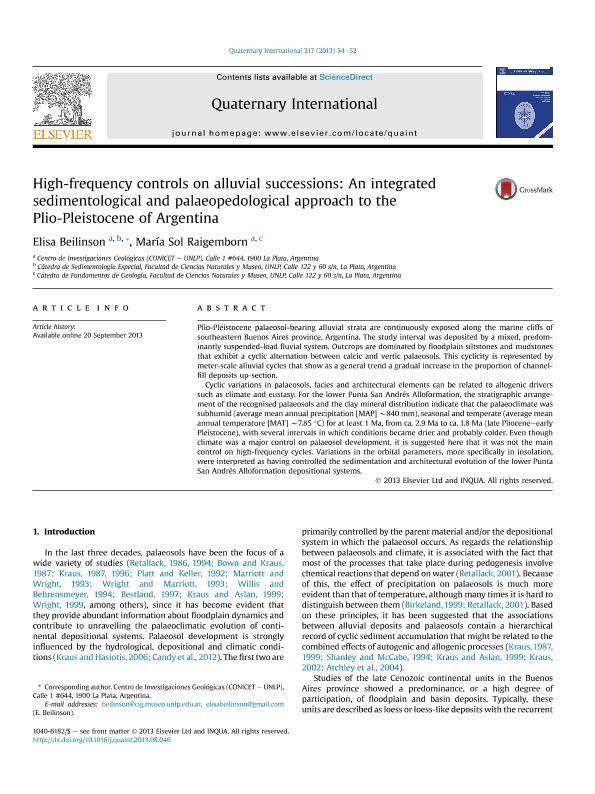Mostrar el registro sencillo del ítem
dc.contributor.author
Beilinson, Elisa

dc.contributor.author
Raigemborn, María Sol

dc.date.available
2017-09-18T19:29:48Z
dc.date.issued
2013-12
dc.identifier.citation
Beilinson, Elisa; Raigemborn, María Sol; High-frequency controls on alluvial successions: An integrated sedimentological and palaeopedological approach to the Plio- Pleistocene of Argentina; Pergamon-Elsevier Science Ltd.; Quaternary International; 317; 12-2013; 34-52
dc.identifier.issn
1040-6182
dc.identifier.uri
http://hdl.handle.net/11336/24502
dc.description.abstract
Plio-Pleistocene palaeosol-bearing alluvial strata are continuously exposed along the marine cliffs of southeastern Buenos Aires province, Argentina. The study interval was deposited by a mixed, predominantly suspended-load fluvial system. Outcrops are dominated by floodplain siltstones and mudstones that exhibit a cyclic alternation between calcic and vertic palaeosols. This cyclicity is represented by meter-scale alluvial cycles that show as a general trend a gradual increase in the proportion of channel-fill deposits up-section. Cyclic variations in palaeosols, facies and architectural elements can be related to allogenic drivers such as climate and eustasy. For the lower Punta San Andrés Alloformation, the stratigraphic arrangement of the recognised palaeosols and the clay mineral distribution indicate that the palaeoclimate was subhumid (average mean annual precipitation [MAP] ∼840 mm), seasonal and temperate (average mean annual temperature [MAT] ∼7.85 °C) for at least 1 Ma, from ca. 2.9 Ma to ca. 1.8 Ma (late Pliocene–early Pleistocene), with several intervals in which conditions became drier and probably colder. Even though climate was a major control on palaeosol development, it is suggested here that it was not the main control on high-frequency cycles. Variations in the orbital parameters, more specifically in insolation, were interpreted as having controlled the sedimentation and architectural evolution of the lower Punta San Andrés Alloformation depositional systems.
dc.format
application/pdf
dc.language.iso
eng
dc.publisher
Pergamon-Elsevier Science Ltd.

dc.rights
info:eu-repo/semantics/openAccess
dc.rights.uri
https://creativecommons.org/licenses/by-nc-sa/2.5/ar/
dc.subject
Paleosols
dc.subject
Paleoclimate
dc.subject
Glacio-Eustacy
dc.subject
Plio-Pleistocene
dc.subject.classification
Oceanografía, Hidrología, Recursos Hídricos

dc.subject.classification
Ciencias de la Tierra y relacionadas con el Medio Ambiente

dc.subject.classification
CIENCIAS NATURALES Y EXACTAS

dc.title
High-frequency controls on alluvial successions: An integrated sedimentological and palaeopedological approach to the Plio- Pleistocene of Argentina
dc.type
info:eu-repo/semantics/article
dc.type
info:ar-repo/semantics/artículo
dc.type
info:eu-repo/semantics/publishedVersion
dc.date.updated
2017-09-14T13:53:45Z
dc.journal.volume
317
dc.journal.pagination
34-52
dc.journal.pais
Reino Unido

dc.journal.ciudad
Oxford
dc.description.fil
Fil: Beilinson, Elisa. Consejo Nacional de Investigaciones Científicas y Técnicas. Centro Científico Tecnológico Conicet - La Plata. Centro de Investigaciones Geológicas. Universidad Nacional de La Plata. Facultad de Ciencias Naturales y Museo. Centro de Investigaciones Geológicas; Argentina
dc.description.fil
Fil: Raigemborn, María Sol. Consejo Nacional de Investigaciones Científicas y Técnicas. Centro Científico Tecnológico Conicet - La Plata. Centro de Investigaciones Geológicas. Universidad Nacional de La Plata. Facultad de Ciencias Naturales y Museo. Centro de Investigaciones Geológicas; Argentina
dc.journal.title
Quaternary International

dc.relation.alternativeid
info:eu-repo/semantics/altIdentifier/doi/http://dx.doi.org/10.1016/j.quaint.2013.08.046
dc.relation.alternativeid
info:eu-repo/semantics/altIdentifier/url/http://www.sciencedirect.com/science/article/pii/S1040618213006666
Archivos asociados
